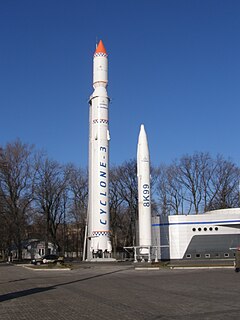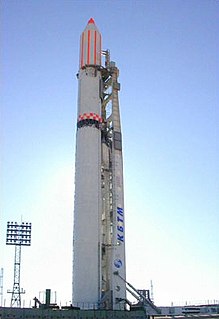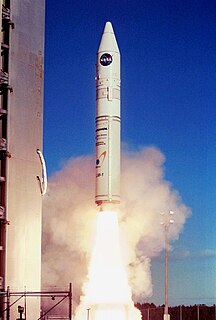Related Research Articles
The Long March 4B, also known as the Chang Zheng 4B, CZ-4B and LM-4B is a Chinese expendable orbital Launch vehicle. Launched from Launch Complex 1 at the Taiyuan Satellite Launch Center, it is a 3-stage launch vehicle, used mostly to place satellites into low Earth orbit and Sun-synchronous orbits. It was first launched on 10 May 1999, with the FY-1C weather satellite, which would later be used in the 2007 Chinese anti-satellite missile test.

The Tsyklon-3, also known as Tsiklon-3 and Cyclone-3, GRAU index 11K68, was a Soviet, and subsequently Ukrainian orbital carrier rocket.
The Long March 3C, also known as the Changzheng 3C, CZ-3C and LM-3C, is a Chinese orbital launch vehicle. It is launched from Launch Complex 2 and 3 at the Xichang Satellite Launch Center (XSLC). A three-stage rocket with two strapon liquid rocket boosters, it is a member of the Long March 3 rocket family, and was derived from the Long March 3B. It was designed to fill a gap in payload capacities between the Long March 3A and 3B.
The Long March 4C, also known as the Chang Zheng 4C, CZ-4C and LM-4C, previously designated Long March 4B-II, is a Chinese orbital launch vehicle. It is launched from the Jiuquan, Taiyuan, and Xichang Satellite Launch Centers, and consists of 3 stages. Long March 4C vehicles have been used to launch the Yaogan-1, Yaogan-3 synthetic-aperture radar (SAR) satellites and the Fengyun-3A polar orbiting meteorological satellite. On 15 December 2009, a Long March 4C was used to launch Yaogan-8.

Site 45 at the Baikonur Cosmodrome is a launch site used by Zenit rockets. It consists of two pads, one of which is still in use. It has been the launch site for all Soviet and Russian government Zenit launches, along with a commercial launch conducted for Globalstar in 1998, and continuing commercial launches under the Land Launch programme. The main pad at the site is area 45/1, which was completed in 1983 following five years of construction. A second pad, area 45/2, was completed in 1990, but was destroyed by a launch failure in the same year.

Launch Pad 0 (LP-0), also known as Launch Complex 0 (LC-0), or Launch Area 0 (LA-0), is a launch complex at the Mid-Atlantic Regional Spaceport (MARS) on Wallops Island, Virginia in the United States. MARS is located adjacent to NASA's Wallops Flight Facility (WFF), which ran the launch complex until 2003. WFF continues to provide various support services to MARS launches under contract with the Commonwealth of Virginia.

Launch Complex 11 (LC-11) at Cape Canaveral Space Force Station, Florida, is a launch complex used by Atlas missiles between 1958 and 1964. It is the southernmost of the launch pads known as Missile Row. When it was built, it, along with complexes 12, 13 and 14, featured a more robust design than many contemporary pads, due to the greater power of the Atlas compared to other rockets of the time. It was larger, and featured a concrete launch pedestal that was 6 metres (20 ft) tall and a reinforced blockhouse. The rockets were delivered to the launch pad by a ramp on the southwest side of the launch pedestal.
Site 133, also known as Raduga, is a launch complex at the Plesetsk Cosmodrome in Russia. It is used by Rockot, and previously Kosmos carrier rockets. It consists of a single pad, originally designated 133/1, and later 133/3.

Yaogan is a broad term used by the People's Republic of China to refer to its military reconnaissance satellites. Yaogan satellites are largely known to primarily support the People's Liberation Army's Strategic Support Force (PLASSF), formerly the Aerospace Reconnaissance Bureau of the Second Department of the General Staff. Yaogan satellites are the successor program to the Fanhui Shi Weixing (FSW) recoverable reconnaissance satellite program but, unlike its predecessor, includes a variety of classes utilizing various means of remote sensing such as optical reconnaissance, synthetic-aperture radar (SAR), and electronic intelligence (ELINT) for maritime surveillance. Yaogan satellites have been launched from the Taiyuan Satellite Launch Center (TSLC) in China's northern Shanxi Province, the Jiuquan Satellite Launch Center (JSLC) in China's Inner Mongolia Autonomous Region, and the Xichang Satellite Launch Center (XSLC) in Sichuan Province.

Launch Complex 18 (LC-18) is a launch complex at the Cape Canaveral Space Force Station, Florida that was active during the late 1950s and early 1960s. It was used by Viking, Vanguard, Thor and Scout rockets. The complex consists of two launch pads, LC-18A, which was originally built by the US Navy for the Vanguard rocket, and LC-18B, which was originally by the US Air Force used for tests of the PGM-17 Thor missile.

Launch Area 4 (LA-4), also known as the South Launch Site or SLS, and LC-43, is the only active Long March launch complex at the Jiuquan Satellite Launch Center. It consists of two launch pads; SLS-1 / 921 (LC-43/91) and SLS-2 / 603 (LC-43/94). SLS-1 has been the launch site for all missions conducted as part of the Shenzhou programme, including the first Chinese crewed spaceflight, Shenzhou 5. Since it was activated in 1999; Long March 2C, Long March 2D, Long March 2F, Long March 4C and Long March 11 rockets have launched from LA-4.

The Athena I, known as the Lockheed Launch Vehicle (LLV) at the time of its first flight and Lockheed Martin Launch Vehicle (LMLV) at the time of its second flight, was an American small expendable launch system which was used for four launches between 1995 and 2001. It is a member of the Athena family of rockets, along with the larger Athena II.

The Athena II is an American small expendable launch system which was used for three launches between 1998 and 1999, and which was scheduled to return to service in 2012 but has not been flown again as of January 2021. It is a member of the Athena family of rockets, along with the smaller Athena I.
Site 110 at the Baikonur Cosmodrome is a launch facility which was used by the N1 rocket during the late 1960s and early 1970s, and by the Energia rocket during the 1980s.

This article documents notable spaceflight events during the year 2018. For the first time since 1990, more than 100 orbital launches were performed globally.
Ziyuan 3-01 or ZY 3-01 is a Chinese Earth observation satellite launched in January 2012. It is a high-resolution imaging satellite operated by the Ministry of Land and Resources of the People's Republic of China.
VesselSat-2 was a Luxembourgian microsatellite built and owned by LuxSpace, and operated by Orbcomm under lease. It carried a receiver for Automatic Identification System signals, used to track ships at sea. VesselSat-2 was the second of two VesselSat spacecraft, which were built by LuxSpace for Orbcomm, as replacements for the AIS capabilities of the failed Orbcomm-QL spacecraft.
The Long March 11, or Chang Zheng 11 as in pinyin, abbreviated LM-11 for export or CZ-11 within China, is a Chinese four stage solid-propellant carrier rocket of the Long March family, which is developed by the China Aerospace Science and Technology Corporation. It was designed with the ability to launch on short notice and it can launch from road vehicles (CZ-11) and ships (CZ-11H). It is likely based on the DF-31 missile. The vehicle can be cold launched from a launch tube mounted on a road mobile vehicle.
References
- 1 2 Wade, Mark. "Taiyuan". Encyclopedia Astronautica. Archived from the original on August 29, 2002. Retrieved 7 March 2010.
- ↑ Barbosa, Rui C (5 March 2010). "China launch YaoGan Weixing-9, announce increase in vehicle production". NASASpaceflight.com. Retrieved 7 March 2010.
- ↑ Wade, Mark. "Taiyuan LC1". Encyclopedia Astronautica. Archived from the original on March 9, 2010. Retrieved 7 March 2010.
- ↑ Barbosa, Rui C (22 April 2009). "Chinese launch again with YaoGan Weixing-6 remote sensing satellite". NASASpaceflight.com. Retrieved 7 March 2010.